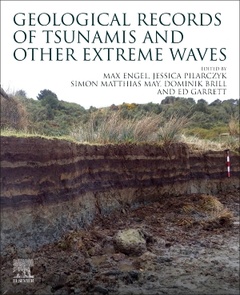Geological Records of Tsunamis and Other Extreme Waves
Coordonnateurs : Engel Max, Pilarczyk Jessica, May Simon Matthias, Brill Dominik, Garrett Ed

Geological Records of Tsunamis and Other Extreme Waves provides a systematic compendium with concise chapters on the concept and history of paleotsunami research, sediment types and sediment sources, field methods, sedimentary and geomorphological characteristics, as well as dating and modeling approaches. By contrasting tsunami deposits with those of competing mechanisms in the coastal zone such as storm waves and surges, and by embedding this field of research into the wider context of tsunami science, the book is also relevant to readers interested in paleotempestology, coastal sedimentary environments, or sea-level changes, and coastal hazard management.
The effectiveness of paleotsunami records in coastal hazard-mitigation strategies strongly depends on the appropriate selection of research approaches and methods that are tailored to the site-specific environment and age of the deposits. In addition to summarizing the state-of-the-art in tsunami sedimentology, Geological Records of Tsunamis and Other Extreme Waves guides researchers through establishing an appropriate research design and how to develop reliable records of prehistoric events using field-based and laboratory methods, as well as modeling techniques.
1 Geological records of tsunamis and other extreme waves: concepts, applications and a short history of research
2 Historical records: their importance in understanding and mitigating tsunamis
3 Tsunami magnitude scales
4 Trigger mechanisms and hydrodynamics of tsunamis
5 Tsunami databases
6 Onshore archives of tsunami deposits
SECTION 2 Field methods
7 Geophysical prospection and sedimentological characteristics of subaquatic tsunami deposits
8 Ground-penetrating radar (GPR) in coastal hazard studies
9 Mapping of subaerial coarse clasts
10 Post-event field surveys
SECTION 3 Fine-Grained deposits
11 The sedimentology and geometry of fine-grained tsunami deposits from onshore environments
12 Foraminifera in tsunami deposits
13 Ostracoda in extreme-wave deposits
14 Diatoms in tsunami deposits
15 The application of molluscs for investigating tsunami deposits
16 Magnetic susceptibility and anisotropy of magnetic susceptibility: versatile tools to decipher hydrodynamic characteristics of past tsunamis
17 X-ray tomography applied to tsunami deposits
18 Applications of geochemical proxies in paleotsunami research
19 Microtextures in tsunami deposits: a useful sediment fingerprinting tool
20 Paleogenetic approaches in tsunami deposit studies
21 Post-depositional changes to tsunami deposits and their preservation potential
22 Erosional signatures and reorganization in ridge-and-swale sequences
23 Experimental and numerical models of fine sediment transport by tsunamis
SECTION 4 Coarse-Clast deposits
24 Spatial patterns of subaerial coarse clasts
25 Mega-tsunami deposits related to ocean island flank collapses and asteroid impacts
26 Erosive impact of tsunami and storm waves on rocky coasts and postdepositional weathering of coarse-clast deposits
27 Experimental models of coarse-clast transport by tsunamis
28 Reconstruction of transport modes and flow parameters from coastal boulders
29 Perspective of incipient motion formulas:boulder transport by high-energy waves
SECTION 5 Dating
30 Radiocarbon dating of tsunami and storm deposits
31 Radiocarbon and U/Th dating of tsunami and storm-transported coarse clasts
32 Optically stimulated luminescence dating of tsunami and storm deposits
33 Archaeological dating of tsunami and storm deposits
34 Tephrostratigraphy and tephrochronology
35 Cosmogenic nuclide dating of coarse clasts References
36 Paleomagnetic dating of wave-emplaced boulders
Geologists, Geochemists, Sedimentologists, Coastal Geomorphologists, Seismologists, Coastal Planners
Dr. Pilarczyk has expertise in coastal geology, micropalaeontology, tsunamis, tropical cyclones, sea level change, palaeoseismology, natural hazards, and temperate, tropical, and arid coastlines. She is currently an Assistant Professor at the University of Southern Mississippi. Previously she held positions as a Postdoctoral Associate at Rutgers University, a Visiting Research Fellow at the Earth Observatory of Singapore, and a Visiting Research Fellow at the University of New South Wales. Dr. Pilarczyk received her PhD in Geology from McMaster University.
Dr. May has expertise in coastal geomorphology, palaeotsunami and palaeotempestological research, geoarchaeology, and geochronology. He currently is a Postdoctoral researcher at the University of Cologne. Previously he served as a Postdoctoral researcher at the German Archaeological Institute, a research assistant and lecturer at the University of Cologne, and a Research assistant and lecturer at the University of Marburg. Dr. May received his PhD in Physical Geography from the University of Cologne.
Dr. Brill has expertise in coastal geomorphology and sedimentology, natural hazard research, geochronology, and luminescence dating. He is currently the Head of Cologne Luminescence Laboratory at the University of Cologne. Dr. Brill’s previous experience includes serving as a Postdoc and Lecturer at the University of Cologne, a research assistant at the University of Cologne, and a research assistant and lecturer at the University of Marburg. He received
- Features a comprehensive overview of the state of the art in tsunami sedimentology and paleotsunami research
- Offers advice on the most appropriate mapping, sampling, and analytical approaches for a wide variety of coastal settings and sedimentary environments
- Provides methodological details for field sampling and the most important proxy analyses
Date de parution : 07-2020
Ouvrage de 848 p.
19x23.3 cm
Thèmes de Geological Records of Tsunamis and Other Extreme Waves :
Mots-clés :
d18O analysis; 3D; Age estimation; Allochthonous articulated bivalves; Ancient DNA (aDNA); Anisotropy of magnetic susceptibility; Antidunes; Archeaological dating; Asteroid impact; Attributes; Backwash; Beach; Beach ridges; Beach-ridges; Bedforms; Boulder; Boulder ridges; Boulder transport model; Boulders; Brackish; Burials; Calibration curve; Cliff-top deposit; Coastal boulder; Coastal boulder deposits; Coastal deposits; Coastal geology; Coastal geomorphology; Coastal hazard assessment; Coastal hazards; Coastal morphology; Coastal risk management; Coastal sediments; Coral boulder; Coral clasts; Coral-rubble ridges; Cross-stratification; Current ripples; Cyclones; Database; Dating coastal storm deposits; Dating tsunami deposits; Diagenesis; Diatom data collection; Diatom sample processing and analysis; Diatoms in tsunami deposits; Disasters; Dissolution; Documentary sources; Dosimetry; Early diagenesis



